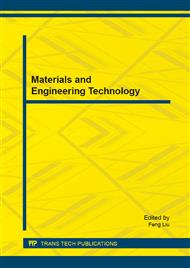[1]
J. A. Raub, M. Marthieu-Nolf, N. B. Hampson, S. R. Thom, Carbon monoxide poisoning—a public health perspective, Toxicology. 145 (2000) 1-14.
DOI: 10.1016/s0300-483x(99)00217-6
Google Scholar
[2]
P. G. Flachsbart, Human exposure to carbon monoxide from mobile sources, Chemosphere: Global Change Science. 1 (1999) 301-329.
DOI: 10.1016/s1465-9972(99)00030-6
Google Scholar
[3]
G. Li, H. Lin, H. Wang, F. Wang, A novel nanometer-scale 'gold electrode-molecular wires-silver', junction: An efficient test bed for electrochemical investigation of electron transportation through molecular wires in self-assembled monolayers, Electrochem Commun. 8 (2006).
DOI: 10.1016/j.elecom.2005.10.017
Google Scholar
[4]
H. Bai, G. Shi, Gas sensors based on conducting polymers, Sensors. 7 (2007) 267-307.
DOI: 10.3390/s7030267
Google Scholar
[5]
E. Sayah, D. Brouri, Y. Wu, A. Musi, P. Da Costa, P. Massiani, A TEM and UV–visible study of silver reduction by ethanol in Ag–alumina catalysts, Applied Catalysis A: General. 406 (2011) 94-101.
DOI: 10.1016/j.apcata.2011.08.016
Google Scholar
[6]
V. E. Kurochkin, E. D. Makarova, Reflectance spectrophotometry of plasticized membranes for the design of fast optical chemosensors, Anal Commun. 33 (1996) 115-116.
DOI: 10.1039/ac9963300115
Google Scholar
[7]
Z. Zhong, R. Xing, S. Liu, L. Wang, S. Cai, P. Li, Synthesis of acyl thiourea derivatives of chitosan and their antimicrobial activities in vitro, Carbohyd Res. 343 (2008) 566-570.
DOI: 10.1016/j.carres.2007.11.024
Google Scholar
[8]
N. B. Arslan, C. Kazak, F. Aydın, N-(4-Nitrobenzoyl)-N-(1, 5-dimethyl-3-oxo-2-phenyl-1 H-3 (2H)-pyrazolyl)-thiourea hydrate: Synthesis, spectroscopic characterization, X-ray structure and DFT studies, Spectrochim Acta A. 89 (2012) 30-38.
DOI: 10.1016/j.saa.2011.12.040
Google Scholar
[9]
A. Kausar, S. Zulfiqar, Z. Ahmad, M. I. Sarwar, Studies on novel thermally stable segmented polyurethanes based on thiourea-derivative diols, Polym Degrad Stabil. 95(12), (2010) 2281-2288.
DOI: 10.1016/j.polymdegradstab.2010.09.006
Google Scholar
[10]
S. Saeed, N. Rashid, P. G. Jones, M. Ali, R. Hussain, Synthesis, characterization and biological evaluation of some thiourea derivatives bearing benzothiazole moiety as potential antimicrobial and anticancer agents , Eur. J. Med. Chem. 45 (2010).
DOI: 10.1016/j.ejmech.2009.12.016
Google Scholar
[11]
Y. F. Yuan, J. T. Wang, M. C. Gimeno, A. Laguna, P. G. Jones, Synthesis and characterisation of copper complexes with N-ferrocenoyl- N'-aryl (alkyl) thioureas, Inorg. Chim. Acta. 324 (2001) 309-317.
DOI: 10.1016/s0020-1693(01)00661-2
Google Scholar
[12]
W. M. Khairul, M. F. Yusof, R. Rahamathullah, A. I. Daud, S. M. Jasman, M. F. A. Hasan, M. G. Tay, Single Molecule Thin Film Featuring Disubstituted Thiourea (TU) Doped with Chlorophyll as Potential Active Layer in Photovoltaic Cell, Int. J. Electrochem. Sci. 8 (2013).
DOI: 10.1016/s1452-3981(23)12877-x
Google Scholar
[13]
G. L. Miessler, D. A. Tarr, Inorganic Chemistry. Pearson Education. Upper Saddle River, NJ, 345. (2004).
Google Scholar
[14]
F. Tavoli, N. Alizadeh, Optical ammonia gas sensor based on nanostructure dye-doped polypyrrole Sensor. Actuat. B-Chem. 176 (2013) 761-767.
DOI: 10.1016/j.snb.2012.09.013
Google Scholar


